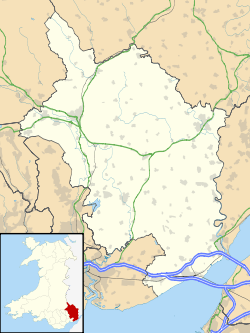St Elli's Church, Llanelly
The Church of St Elli, Llanelly, Monmouthshire, Wales, is a parish church with its origins in the 14th century. The church underwent three major restorations, in 1867–1868, 1897 and 1910–1911. It remains an active parish church.
| Church of St Elli | |
|---|---|
"monuments of unusually high quality" | |
 Church of St Elli Location in Monmouthshire | |
| Location | Llanelly, Monmouthshire |
| Country | Wales |
| Denomination | Church in Wales |
| History | |
| Status | parish church |
| Founded | early 14th century |
| Architecture | |
| Functional status | Active |
| Heritage designation | Grade II* |
| Designated | 19 July 1963 |
| Architectural type | Church |
| Administration | |
| Parish | Llanelli |
| Deanery | Greater Brecon |
| Archdeaconry | Brecon |
| Diocese | Swansea and Brecon |
| Clergy | |
| Vicar(s) | The Reverend C J Bevan |
The church is dedicated to the 6th-century Saint Elli, who may have been a daughter or granddaughter of King Brychan, or a male disciple of Saint Cadoc.
History
The church dates from the 14th century, or earlier,[1] but little remains of this period.[2] The nave is medieval[1] but its walls were all rebuilt in the restorations of the 19th and 20th centuries.[2] The first of these rebuildings took place in 1867–1868, and was undertaken by the architect Joseph Nevill of Abergavenny.[1] The spire dates from the restoration of 1897 by Baldwin of Brecon.[2] The final rebuilding was undertaken by J. Vaughan Richards of Crickhowell in 1910–1911.[1]
Until local government reorganisation of 1974, the parish of Llanelly was in the historic county of Brecknockshire[2] and St Elli's remains an active church under the administration of the Diocese of Swansea and Brecon, although the parish is now in Monmouthshire.[3]
Architecture and description
The church is built of Old Red Sandstone rubble.[1] It comprises a nave with west tower, chancel, aisle and porch.[1] The architectural historian John Newman considered the "broad and squat" tower the most memorable feature.[2]
The interior contains some monuments of "unusually high quality"[1] which are noted in the church's listing record for its Grade II* designation.[1]
Notes
- "Listed Buildings – Full Report – HeritageBill Cadw Assets – Reports". Cadwpublic-api.azurewebsites.net. Retrieved 2017-08-12.
- Newman 2000, p. 279.
- "Benefices". The Church in Wales. 2015-10-21. Retrieved 2017-08-12.
References
- Newman, John (2000). Gwent/Monmouthshire. The Buildings of Wales. London: Penguin. ISBN 0-14-071053-1.